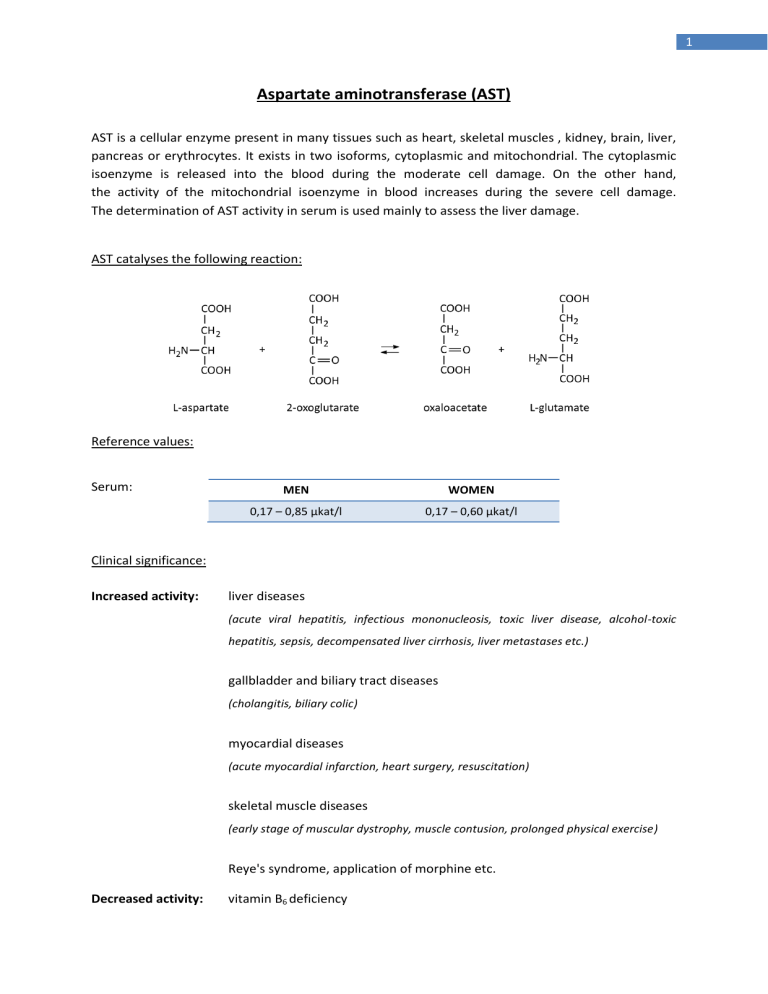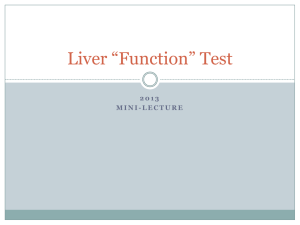
1 Aspartate aminotransferase (AST) AST is a cellular enzyme present in many tissues such as heart, skeletal muscles , kidney, brain, liver, pancreas or erythrocytes. It exists in two isoforms, cytoplasmic and mitochondrial. The cytoplasmic isoenzyme is released into the blood during the moderate cell damage. On the other hand, the activity of the mitochondrial isoenzyme in blood increases during the severe cell damage. The determination of AST activity in serum is used mainly to assess the liver damage. AST catalyses the following reaction: Reference values: Serum: MEN WOMEN 0,17 – 0,85 µkat/l 0,17 – 0,60 µkat/l Clinical significance: Increased activity: liver diseases (acute viral hepatitis, infectious mononucleosis, toxic liver disease, alcohol-toxic hepatitis, sepsis, decompensated liver cirrhosis, liver metastases etc.) gallbladder and biliary tract diseases (cholangitis, biliary colic) myocardial diseases (acute myocardial infarction, heart surgery, resuscitation) skeletal muscle diseases (early stage of muscular dystrophy, muscle contusion, prolonged physical exercise) Reye's syndrome, application of morphine etc. Decreased activity: vitamin B6 deficiency 2 Alanine aminotransferase (ALT) ALT is a cytoplasmic enzyme. It is primarily localized in hepatocytes. It is released into the blood during the cell damage. The determination of ALT activity in serum is used mainly to assess the liver damage. ALT catalyses the following reaction: Reference values: Serum: MEN WOMEN 0,17 – 0,83 µkat/l 0,17 – 0,58 µkat/l Clinical significance: Increased activity: liver diseases (acute viral hepatitis, infectious mononucleosis, toxic liver disease, alcohol-toxic hepatitis, sepsis, decompensated liver cirrhosis, liver metastases etc.) gallbladder and biliary tract diseases (cholangitis, biliary colic) myocardial diseases (heart failure with congestion of blood in the liver) Reye's syndrome therapeutic application of bovine or porcine heparin etc. Decreased activity: vitamin B6 deficiency 3 THE DETERMINATION OF AST AND ALT ACTIVITY IN BLOOD SERUM PRINCIPLE OF THE METHOD The determination is based on the absorbance of hydrazones of 2-oxoglutarate and pyruvate in an alkaline medium. AST catalyses the transfer of an amino group from L-aspartate to 2-oxoglutarate to form oxaloacetate and L-glutamate. Oxaloacetate spontaneously decarboxylates to form pyruvate under the strongly acidic conditions. ALT catalyses the transfer of an amino group from L-alanine to 2-oxoglutarate to form pyruvate and L-glutamate. An increase in pyruvate concentration corresponds with the levels of AST and ALT activities. The pyruvate concentration is determined spectrophotometrically in the form of hydrazone, which is produced by reaction with 2,4-dinitrophenylhydrazine in an alkaline medium. The pyruvate hydrazone absorbs at 510 nm more than 2-oxoglutarate hydrazone. MATERIALS AND INSTRUMENTS commercial diagnostic kits BIO-LA-TEST ALT, AST (Erba Lachema s.r.o.), tubes, a graduated pipette, an automatic pipette, a pipette pump, a cuvette, a spectrophotometer SPEKOL 1300 CHEMICALS standard solution (2 mmol/l sodium pyruvate) 2,4-dinitrophenylhydrazine (2,4-DNPH; solution of 1mmol/l in 1 mol/l of HCl) sodium hydroxide substrate AST (0,1 mol/l L-aspartate; 2 mmol/l 2-oxoglutarate; 0,1 mol/l phosphate buffer pH 7,4) substrate ALT (0,2 mol/l DL-α-alanine; 2 mmol/l 2-oxoglutarate; 0,1 mol/l phosphate buffer pH 7,4) physiological saline (0,9 % NaCl) 4 PROCEDURE 1. Pipette the solutions into the labelled test tubes according to the table. substrate AST/substrate ALT physiological saline SAMPLE tube 1 BLANK tube 2 250 μl 250 μl — 50 μl Mix and preincubate at 37 °C for 3 minutes, then introduce: sample (serum) 50 μl — Mix and incubate at 37 °C for exactly 60 minutes, then introduce: 2,4-DNPH 250 μl 250 μl Mix and let stand at the laboratory temperature for 20 minutes, then introduce: sodium hydroxide 2,5 ml 2,5 ml Mix and incubate at the laboratory temperature for 10 minutes. Read the absorbance of the sample at 510 nm against the blank. 5 CALIBRATION solution resulting catalytic concentrations (μkat/l) 1 2 3 4 5 0,00 0,28 0,56 0,83 1,11 1. Pipette the individual solutions in given order into the labelled test tubes according to the table. solution physiological saline (ml) 1 2 3 4 5 0,10 0,10 0,10 0,10 0,10 substrate AST/ALT (ml) 0,50 0,45 0,40 0,35 0,30 standard solution (ml) — 0,05 0,10 0,15 0,20 2,4-DNPH (ml) 0,50 0,50 0,50 0,50 0,50 5,00 5,00 Mix and after 20 minutes add: sodium hydroxide (ml) 5,00 5,00 5,00 Mix and incubate at the laboratory temperature for 10 minutes. Read the absorbances of solutions no. 2 – 5 at 510 nm against solution no. 1. 2. Write the measured values into the table. 3. Draw the graph of the dependence of absorbance on the catalytic concentrations. 6 MEASURED VALUES CALIBRATION CURVE absorbance (A) catalytic concentrations (μkat/l) 0,00 0,28 0,56 0,83 1,11 TEST SAMPLE absorbance (A) GRAPHICAL REPRESENTATION CONCLUSION catalytic concentration (μkat/l)





